In May, 2011 a neighbor wrote to me while we were in Illinois, reporting that he found a nesting colony of 5-6 pairs of Yellow-crowned Night-Herons in "our" local birding patch. They were in a corner I never had investigated.
Without his help I would not have found them, as they were very well concealed in trees along a storm-water canal. Two of the nests had adults incubating eggs or brooding small chicks. We also found three immature Green Herons with their parents near another nest.
Over the years we have seen the nests of up to 8 pairs of Yellow-crowned Night-Herons and 3-5 pairs of Green Herons. A pair of Black-crowned Night Herons raised at least one chick but concealed their nest very effectively.
Hurricane Irma struck on September 7, 2017, and drastically changed the little rookery. Although the storm hit after breeding season, it pushed many of the nest trees and shrubs into the canal. Last spring I found only one Yellow-crowned Night-Heron nest.
The regional authority which maintains the drainage canals periodically treats the stream-side vegetation with herbicides, but more had to be done to keep the waterway open. I learned of their plans and alerted them to the existence of the rookery.
They came in with chainsaws and cleaned out fallen trees and shrubs which amounted to about one third of the rookery, but did leave more than half of the vegetation undisturbed. However, they cut down several of the larger trees which extended over the water and clear-cut one large area of thick brush, sites of nests during previous years.
This winter up to 6 Yellow-crowned Night-Herons have visited, but only five were present this week, three males, one female, and a probable first year immature bird in drab plumage. Adults' plumage brightens up and their legs change color from black to yellow and then to bright red as breeding season advances. Both sexes grow head (occipital) and upper back (scapular) plumes, and their crowns turn from streaky white to clear yellow. The plumes of the males are noticeably longer.
On February 25 I arrived at the rookery about 20 minutes before sunrise. There was light fog and it was still too dark for photos, but I observed a pair engaged in a courtship ritual. I obtained this image at about 15 minutes before sunrise. The male is on the left. Note his longer head plumes:
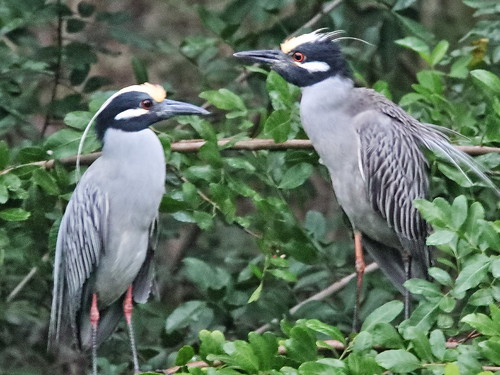
This sequence shows his display, which takes place in less than a second.
He stands up very straight, bill raised:
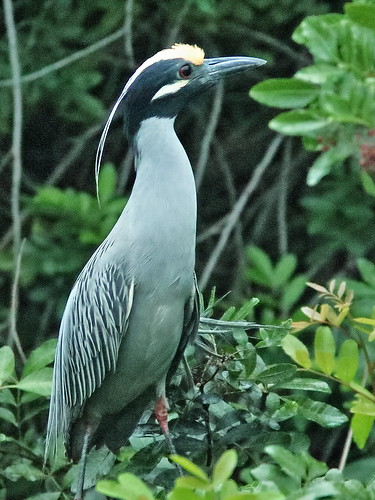
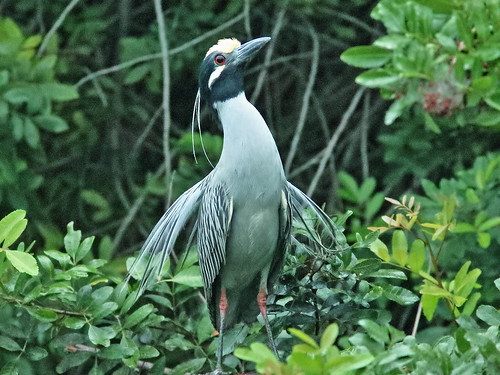
He extends his scapular plumes:
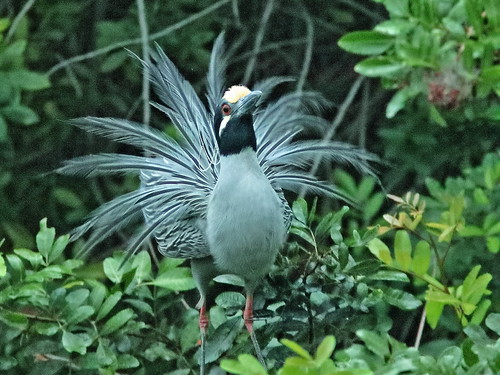
Wings are pointed up and he bows deeply:
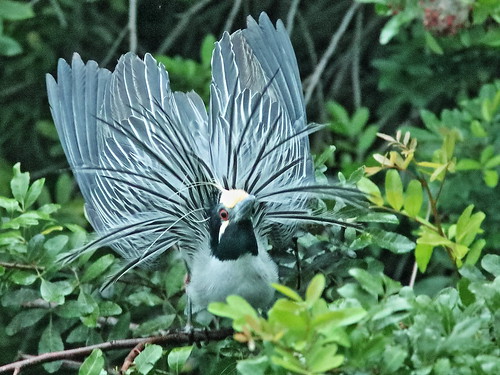
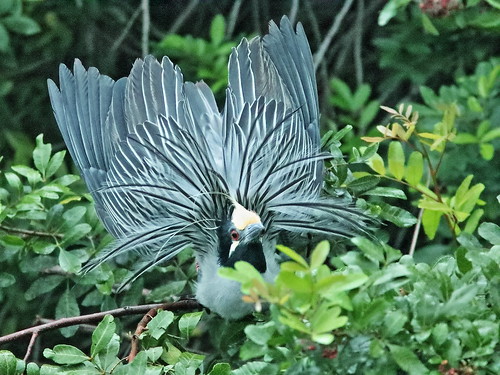
Suddenly, he reacts to the presence of the second male as it flies by. Now the display is intended as a threat:

The next morning the pair was actively engaged in building a nest. There was a bit of ceremony each time the male brought in a stick. The female grasped and seemed to inspect each offering before the male placed it on the nest platform:
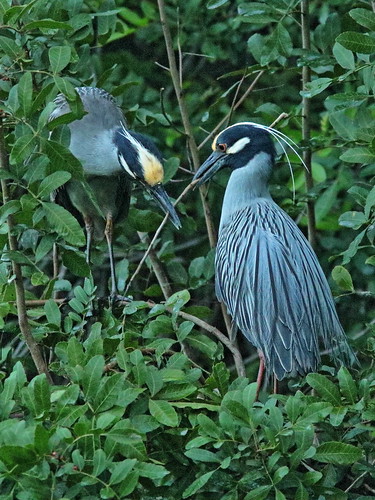
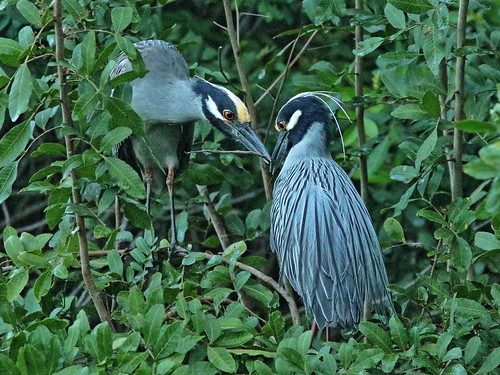
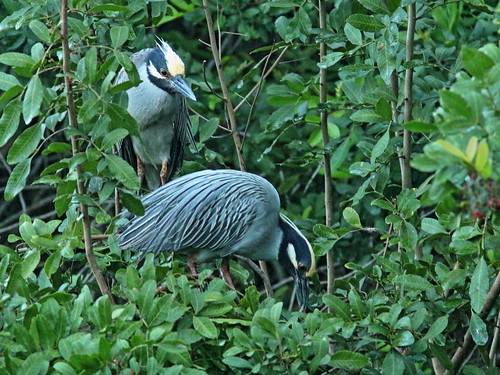
The male almost ignored my presence and flew across the canal to pick up a stick. He was so close to me that I could not fit all of him in my viewfinder:

Here the male displays as he arrives with a stick:



Video slide show of display:
These photos document the changes in the rookery--
View to north end on April 22, 2012:
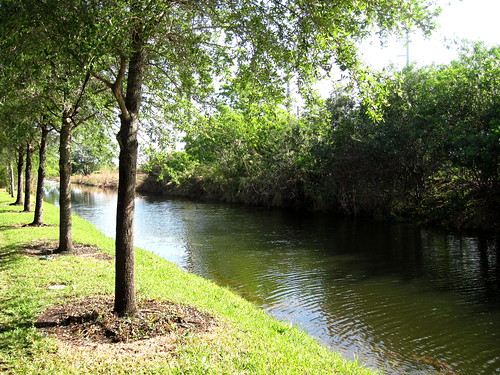
Rookery on March 21, 2014:

View to south after Hurricane Irma, October 26, 2017:

After about a third of the rookery was clear-cut, November 27, 2018:
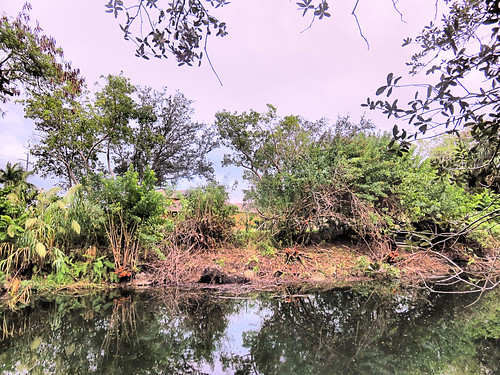
The waning crescent Snow Moon had a rendezvous with the Planet Jupiter on the morning of February 27. Jupiter and some of its moons may be visible at the bottom of this frame:
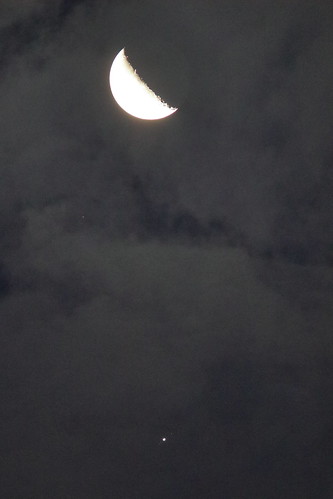
Full Snow Moon setting just before sunrise on February 20:
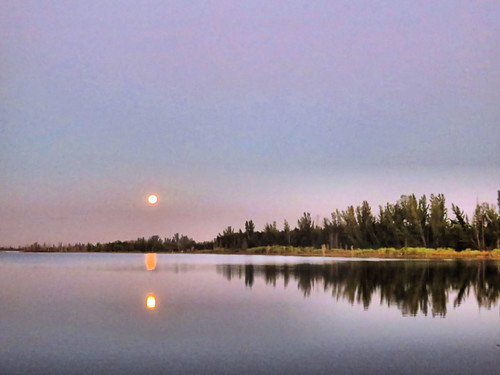
= = = = = = = = = = = = = = =
Linking to Misty's CAMERA CRITTERS,
Linking to Eileen's SATURDAY'S CRITTERS,
Linking to SKYWATCH FRIDAY by Yogi, Sylvia and Sandy
Linking to WEEKEND REFLECTIONS by James
Linking to BirdD'Pot by Anni
Linking to Our World Tuesday by Lady Fi
Linking to Wild Bird Wednesday by Stewart
Linking to Wordless Wednesday (on Tuesday) by NC Sue
Linking to ALL SEASONS by Jesh
________________________________________________
Please visit the links to all these memes to see some excellent photos on display
I'm glad you get out enough for the two of us.
ReplyDelete(sigh)
Fabulous photos and I love the mating display. I hope the trees soon grow again and the rookery survives. Happy March, Diane
ReplyDeleteWhen engineers get on a project, they have no consideration for natural areas. they can always do it better.
ReplyDeleteWow, that's quite a display and very cool you were able to catch it!
ReplyDeleteWOW! That is wonderful that you captures photographs of the mating display Kenneth. Fascinating.
ReplyDeleteThe early man gets the best bird photos!
ReplyDeleteWhat a beautiful reflection!
Marvelous! How wonderful to see the courtship.
ReplyDeleteNice capture of the moon !
ReplyDeleteHello, what an awesome post on the Yellow-crowned Night Heron. It is great to see the courtship, the display of feathers is beautiful. Wonderful post and photos. Thank you for linking up and sharing your post. Happy Saturday, enjoy your weekend. PS, thank also for leaving me a comment.
ReplyDeleteI don't think we've ever seen the yellow crowned night heron! Something for us to watch for and hope to see here! Enjoy your weekend!
ReplyDeleteThose Herons are cool.
ReplyDeleteI really really enjoyed this so much. The courting ritual is superb in your photos!! And your commentary is such a fabulous addition.
ReplyDeleteI want to send along my thanks for linking in & sharing your post with us birders at I'd Rather B Birdin this week!
Beautiful captures.
ReplyDeleteThe display pictures are great. That is some substantial change to the habitat. Hope the rookery recovers in the end.
ReplyDeleteCheers - Stewart M - Melbourne
Thank you for sharing this wonderful post... never heard before of this bird - they must be protected.
ReplyDeleteLove your beautiful photos and the explanation of the rituals - thanks!
ReplyDeleteThese are all great shots!
ReplyDeleteBut especially the bird photos impress me very much.
These are really great animals and they have taken a perfect series.
My respect
OMG, what beautiful shots.
ReplyDeleteWorth a Thousand Words
Happy for you that you were able to find the rookery! My goodness, this bird - what a beauty - everything about him. especially when his wings are raised! What a treat to share this with All Seasons, Ken! Thank you much and have a lovely week:)
ReplyDeleteIt's such a shame about the lost nests. Hopefully, they will adapt well. Your photos are just incredible! Thank you so much for sharing them with us!
ReplyDeletefabulous photos of the mating display.
ReplyDeleteI would love to see this display.
ReplyDeleteGreat shots! What lens are you using for the heron photos? Have a great weekend!
ReplyDelete@Kelleyn-- my camera specs-- Hand-held Canon EOS 80D with EF 300mm f/4L IS USM and EF 1.4X II Extender (420 mm f/5.6 lens system, 672mm 35 mm equivalent). Since these were taken around sunrise in deep shade at f/5.6 I decreased exposure compensation by 1/3 to 2/3 and ISO was quite high 6400), accounting for the softening of the images. Using a tripod or monopod under these lighting conditions would have been ideal but I stopped carrying one because of the weight of my gear, nearly 20 pounds already.
ReplyDelete